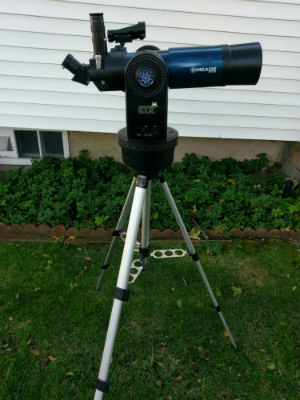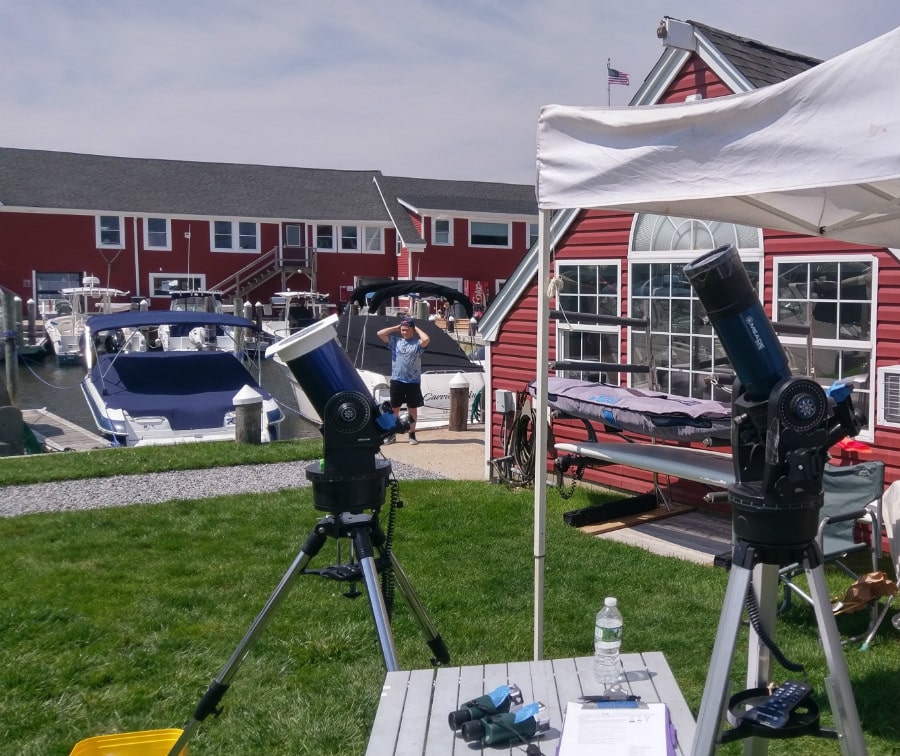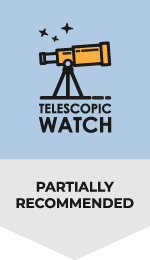The Meade ETX 80 observer is part of the new, updated ETX Observer series which also includes new versions of the ETX 90 Observer and the reintroduction of the ETX 125 Observer. These scopes have been so popular over the years that Meade just keeps improving and enhancing them. The ETX-80 Observer is the smallest scope in the line and the only refractor, providing a wide field of view albeit with rather little in the way of brightness or resolving power.

The Optical Tube
The ETX-80 Observer is an 80mm f/5 achromatic refractor with a 400mm focal length, almost identical to the Orion ShortTube 80 and Meade Infinity 80. The main difference is that the ETX-80 Observer features a built-in flip mirror diagonal instead of a detachable 1.25” star diagonal like most refractors do, and it focuses by moving the objective lens back and forth rather than the eyepiece holder, in an attempt to keep the telescope as compact and user-friendly as possible.
Accessories
The ETX-80’s included 26 mm Plossl eyepiece gives you 15X. The included 9.7 mm Plossl eyepiece gives you 41X. These are good magnifications for general use of the scope. The ETX-80’s fast achromatic optics mean it really can’t handle much over 80x, and while you could go lower than 15x with something like a 32mm Plossl we wouldn’t really advise it due to the brightened background and the negligible difference in the field of view.
A red dot finder is included. This is a good match to the ETX 80 Observer as this is typically only needed during set-up. Once you have the scope aligned you can turn this off as the scope will find the targets for you. The ETX-80’s short focal length means that sighting along the tube will work in a pinch if the finder’s battery dies – 15x is the magnification of some finderscopes and binoculars anyways.
The integrated star diagonal also has a threaded port on the back, not something you will see on other telescopes in this class. Purchase the appropriate adapter for your brand of DSLR camera and you can mount your camera to the back of the scope. You can look through the eyepiece and then flip the mirror and have the light go to the camera.
Lastly, the ETX-80 includes a thread-on plastic dew shield for the objective lens. You are likely to want to use this at all times – not only to prevent condensation on the lens, but also to keep stray light and glare out to increase the contrast in your views at the eyepiece.
Mount
The ETX-80 Observer is a GoTo telescope running off Meade’s latest and greatest hand controller and software, the AudioStar. The AudioStar controller is essentially a glorified pocket calculator that has speakers on it. When it slews to new targets, it will start talking about some basic facts about the object. Depending on your knowledge of astronomy, you might find this feature either extremely helpful or extremely annoying.
Six AA batteries go inside the base of the scope so there are no external battery packs or power supply needed. Some other computerized scopes require an external pack which can be inconvenient to use, or which can be forgotten at home.

A great feature of the Meade ETX Observer line is that you can use these telescopes manually. Let’s say your batteries died. Many other computerized scopes would be dead, unusable, but not the ETX-80 Observer. If you want to use the scope manually, which I do from time to time, you can unlock the clutches and point the scope yourself. Many computerized scopes do not allow you to do this, but the ETX 80 Observer makes it easy.
Another interesting enhancement is that the optical tube can be easily removed from the mount with two screws. Previous versions made it very difficult to remove the optical tube if you wanted to put it on a different mount.
Another great advantage of this design is that you can use the Meade ETX 80 Observer on the included tripod or as a tabletop scope.
With the ETX 80 Observer the brains are in the base of the scope and the handset. Take it off the tripod and put it on a table and you have a fully functional computerized robotic system. This makes it even easier to travel with as you don’t have to bring the tripod.
It all comes packaged in a very nice quality backpack along with a fold-up tripod so you can pack it away, toss it in the car for travel, take it on a hike or hang it on the wall for storage. For teens, they can put on the backpack and bicycle to the local schoolyard or park.
If there is one weakness in the package it is that the tripod is a bit lightweight. This is in keeping with the backpack, lightweight and easily portable concept of the ETX 80 Observer. This can lead to some image shake during focusing or in a strong breeze. If you wish, Meade does sell an optional tripod that is heavier and more robust should you wish to add that in the future. Of course, you don’t have to use the tripod at all, just place it on a sturdy table, stool or a level rock and you are all set.
Should I buy a Used ETX-80 Observer?
The ETX-80 Observer is a decent scope, and should you find one used at a good price we’d recommend it – with the caveat that a Dobsonian or larger aperture computerized scope will show you a lot more. Older versions of the ETX-80 such as the ETX-80 AT are similarly good, but demand a lower price.
Alternative Recommendations
There are a few GoTo as well as non-GoTo telescopes around the ETX-80’s price range that we might recommend instead. The Celestron Astro-Fi 102 offers a little more aperture than the ETX-80 in a similarly compact package, but with an easier-to-use control system based around your phone or tablet. A 6” Dobsonian like the Orion SkyLine 6, Apertura DT6, or Sky-Watcher 6” Classic Dobsonian offers nearly double the aperture of the ETX-80, providing huge gains in resolution and deep-sky views about 4 times as bright. And for a little more money, you could get an 8” or 10” Dobsonian from one of the aforementioned brands, with even sharper and brighter views. You could also pick up the Celestron Astro-Fi 130, which will offer less aperture than the Dobsonian options but a wide field of view and the same easy-to-use GoTo system of the Astro-Fi 102.
Aftermarket Accessory Recommendations
A 6mm “gold-line” eyepiece will provide 67x with the ETX-80, which is close to the limit of what the scope can handle. For viewing the moon and planets, you’ll likely get better results with this eyepiece than the stock 9.7mm Plossl. If you’re seeking to make the ETX-80 your convenient “grab n’ go” telescope, the Celestron 8-24mm Zoom can be kept in the eyepiece holder at all times and allows you to quickly change magnifications, at the expense of a narrow field of view at low magnification.
A small rechargeable power supply is another great idea for the ETX-80 Observer, allowing you to avoid burning through AA batteries on the regular or worry about corrosion.
What can you see with ETX 80 Observer?
As it’s a fast, inexpensive achromatic refractor, the ETX-80 Observer is really meant for low-power viewing of deep-sky objects such as nebulae and star clusters. Unfortunately, its small aperture means that said views are likely to be relatively disappointing under even dark skies, let alone the light-polluted skies many users are likely to be stuck under. The ETX-80 can show you great views of the Moon and will reveal the moons and basic details of Jupiter and Saturn, but don’t expect high-contrast views of Mars’ surface or the minute shades of Jupiter’s cloud bands. It also has a bit of a hard time splitting close double stars due to the chromatic aberration, otherwise known as false color, inherent in its optics.
The ETX-80 will show you galaxies, globular clusters, and nebulae, but don’t expect much. Galaxies and globulars will look like little more than mere smudges no matter how good your viewing conditions are. Planetary nebulae like the Ring and Cat’s Eye are too small to resolve at the low magnifications the ETX-80 performs best at, and quickly get too dim as you increase the magnification. The Orion Nebula, Swan, and Lagoon look decent under darker skies, while only their bright centers will be visible under light-polluted conditions with the ETX-80 Observer.
The ETX-80 Observer is arguably best for viewing beautiful open star clusters like the Pleiades, the Hyades, the Double Cluster, Owl Cluster and so many more. These are great targets, even in light-polluted areas.


